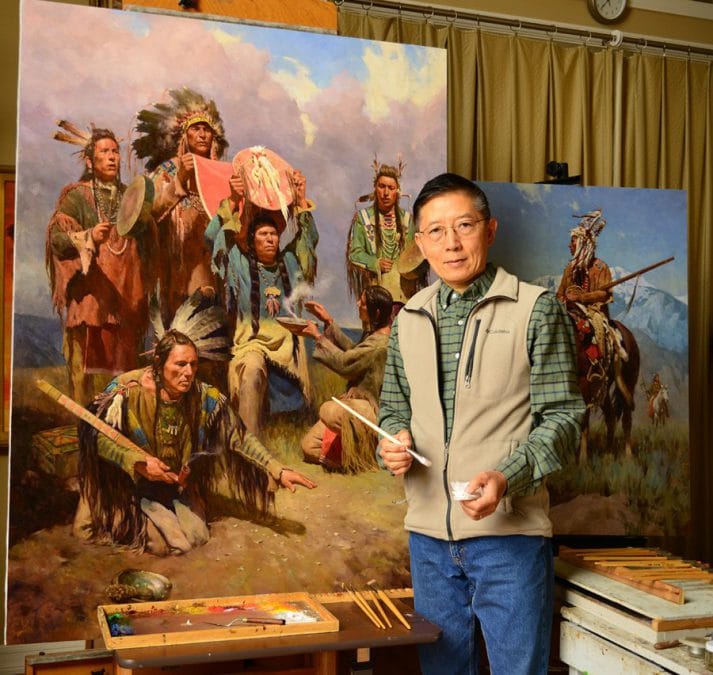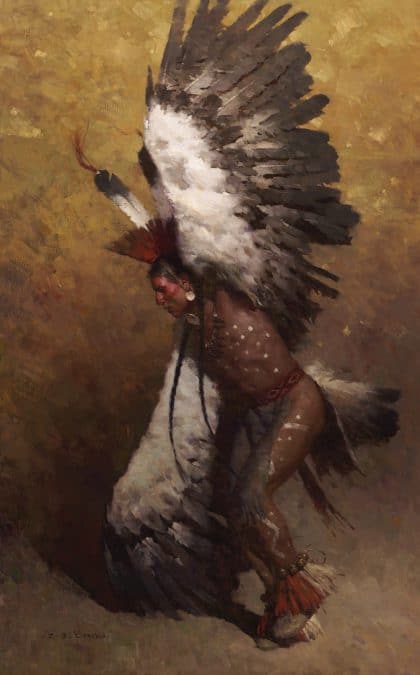Western artist Z.S. Liang spent the last two decades of his career learning and painting images of Native American history, culture and tradition. He earned degrees in art from universities in both Beijing and Guangzhou, China, as well as Boston, Massachusetts.

Liang started depicting Native-inspired subject matter in 2002 and wound his focus down to the 19th century — more specifically from 1803 to 1890, beginning with the Lewis and Clark expedition and concluding with Sitting Bull’s death. Contact between tribes and the United States increased during this period as more colonists began moving west. It resulted in the exploitation and severe assimilation of Indigenous peoples, including the Potawatomi Trail of Death in 1838.
“The life of the Indian fundamentally changed because everything, basically, from the government. Once you have everything from government, you don’t have much choice,” said Liang, whose first language is not English.
Born in Guangzhou, China, he had never seen anything like Native culture before, and he wanted to share it with the rest of the world. Filling gaps in the artistic representation of Indigenous stories remains the goal of Liang’s career. He believes even if people read little about American Indians, his artwork catches people’s attention and establishes a base for knowledge from an initial exposure to their way of life.
“I can tell the story visually on my canvas to people rather than people to read the story. How many people can read the story? And how many people can see this story?” Liang said.
With an obvious intelligence and desire to continue learning throughout his life, Liang researches various tribes to decide on his next subject matter. That includes visiting museums, talking to Indigenous people across the country and finding new historical novels. Accuracy in his art remains one of Liang’s primary concerns.
“(A historical painting) has to obey. It has to be true in the history, and that painting, it becomes valuable,” he said.
After moving to the United States, Liang spent over a decade making a living by painting portraits. His desire and love for Native culture and a shift in his art’s subject matter came after a chance encounter.
Plimoth Plantation and the Wampanoag Homesite
In 2002 while living in Boston, Massachusetts, Liang became enthralled with the Wampanoag Homesite of the Plimoth Plantation living history museum in Plymouth, the site of the docking of the Mayflower in 1620. The Wampanoag portion shows Native Americans’ way of life before colonization.
He visited the museum a couple of times but noticed the Wampanoag area after seeing an advertisement at a turnpike rest stop. He quickly returned and met American Indians willing to share.
“I want to paint something that has a story and paint something realistic, but I don’t know how. I don’t know what I can paint,” Liang said. “And when I look at that, and then all the sudden … I thought, ‘Wow, this is very interesting.’”
One man in particular patiently explained his tribe’s customs. He taught Liang everything from agricultural methods including the Three Sisters (corn, beans and squash) to how to hunt deer and combat strategies. Afterward, he modeled for Liang.
“I asked him many questions, and he shows me as much as he can. So, that’s the first time. I’ve never have a chance to talk to an Indian before,” Liang said.
“I read a pile — almost like 2 feet high pile — of books from the library because books can tell you many about their history.”
Afterward, he engulfed himself, attending powwows, meeting people from tribes across the country and studying historic photographs. A gallery accepted his first three or four paintings for display. Within a few months, he switched from portraits to Indigenous scenes full time.
To this day, he travels throughout Montana, Wyoming, Arizona, New Mexico and South Dakota for research.
Eagle Dancer Potawatomi

Approximately 10 years ago, Liang attended a powwow at the Autry Museum of the American West in Los Angeles where he saw a dancer wearing full wings on his arms and across his back.
“I’d never seen that before, and it’s so real, and it’s all make from the eagle feathers, Golden Eagle feathers,” Liang said.
“He was an eagle stands, dancing and immediately, I said, ‘That can be a great painting.’ That’s how I approach him and ask him to do the modeling.”
The image became Eagle Dancer Potawatomi, a stunning portrait of an Ojibwe man performing a traditional number honoring the Anishinabek tale of the eagle in a color palette of browns, greys, blacks and whites.
The Briscoe Western Art Museum in San Antonio, Texas, displayed the painting.
“I was so glad. There’s someone collect and putting into someone’s house where nobody can see, and museum everybody can see. That’s wonderful,” Liang said.
As his career progresses, Liang finds his excitement about Native culture growing, including “what they believe, and about the traditions … respect for nature and how to relate to the kind of religion and to relate to nature and human beings and the animals. All this, I think, has a universal value,” he said.
That excitement and reverence translated into more than 200 paintings over more than 15 years.
“I try to paint as many as I can to find a story never painted before and almost no one knows before,” Liang said. “I think that is my mission.”
Each year, Liang participates in the Prix de West art show at the National Cowboy and Western Heritage Museum in Oklahoma City. Visit his work online at liangstudio.com.
